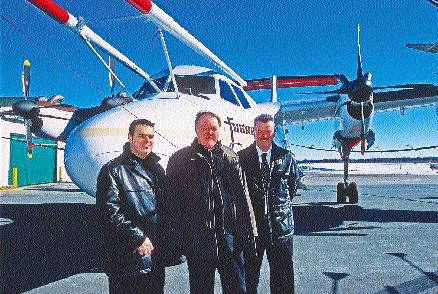With a little encouragement from a province anxious to secure its mining future,
This time, the senior is sending in the big guns: high-tech exploration tools designed to probe the camp’s notoriously complex geology and uncover buried base metal deposits that may have eluded previous explorers.
“Up until the 1990s, the basic approach for the Bathurst camp was to combine airborne geophysics with soil geochemistry” explains Michael Taylor, president of
Megatem, operated by Fugro Airborne Surveys, is a time-domain airborne EM system that can detect massive sulphide deposits up to 250 metres below the surface. Noranda discovered the Perseverance deposit, which hosts 5.1 million tonnes of reserves grading 15.8% zinc and 1.24% copper, using this technology in Matagami, Que., another aging mining camp.
FTG, the chosen airborne gravity system, was developed recently by U.S.-based Bell Geospace. The FTG system is considered an improvement on BHP Billiton’s related Falcon system because it can measure changes in gravity in any direction, allowing both vertical and lateral distinction between stratigraphic or structural units with differing densities.
Under the terms of the 50-50 joint venture, the partners will spend a total of $25 million ($5 million per year over five years) scouring the Bathurst camp for volcanogenic massive sulphide (VMS) deposits that might extend the life of Noranda’s 40-year-old Brunswick #12 mine. The mine, once one of the biggest zinc deposits in the world, is scheduled to close in 2008.
“Before the Brunswick mine shuts down, we would want to know we had made an effort to replace those reserves,” says Taylor. “If we make a discovery, we should be able to put it on the fast track to production because the infrastructure is there and the mill is running out of ore.”
For the first three years of the program, Noranda’s $2.5-million annual contribution will be refunded by the New Brunswick government under a new grant system designed to encourage producing companies to explore in the region. The grant has a 3-year budget of $15 million and is eligible for an extension of two years and an additional $10 million. Advanced exploration technologies will be funded equally by the government and the private sector.
“We’re hoping such an initiative may ensure that mining continues in this region and that we will be able to find a new orebody to maintain nearly 1,000 jobs at the Brunswick mine,” Keith Ashfield, minister of the New Brunswick Department of Natural Resources and Energy, said when the grant was announced last autumn.
The work is now under way, with airborne surveys flying over at least 518 sq. km of claims that cover volcanic and sedimentary rocks considered highly prospective for massive sulphide deposits.
If the airborne surveys generate targets, the partners will use ground geophysics and drilling to gather more information from surface to roughly half a kilometre deep (where the economics of mining begin to diminish). A deep-penetrating induced-polarization system called Titan 24, combined with down-hole seismic technology, is the most likely ground technique, says Steve McCutcheon, a government geologist who has been monitoring activity in the camp for several years.
Nepisiguit Falls
Base metal deposits in the Bathurst camp are contained mostly in Ordovician volcanic and sedimentary rocks of the Tetagouche group. Within that group, Noranda and Slam are focusing on the Nepisiguit Falls Formation, which hosts the Brunswick (#12 and #6), Heath Steele and Half Mile Lake deposits. This unit consists of quartz-feldspar crystal tuffs.
The deposits are all stratiform proximal-type resting mostly within chloritic mudrocks at or near the top of the volcanic pile, says McCutcheon. The exception is Heath Steele, which sits at the lower part of the formation.
Because VMS deposits tend to occur in clusters, several waves of exploration have washed over the Bathurst camp during its 50-year history. Each new wave carried with it the expectation that a deposit matching Brunswick #12’s grandeur would be found. Although more than 40 deposits have been discovered, only a handful are considered economic.
Noranda alone was spending several million dollars a year on the search for new sources of ore until 2001, when its bean counters in Toronto closed the Bathurst exploration office. Just before they packed their bags, members of the Noranda exploration team were beginning to test some of the high-tech tools now in use.
“Noranda had flown test surveys of Megatem and they were doing 3-D seismic,” says McCutcheon. “It looked like they were making the next leap forward in terms of geophysical technology and our understanding of the geology of the camp. Then the plug got pulled.”
Both the government and the private sector in New Brunswick hope the application of sophisticated exploration technology this time around will be the key to unlocking new riches in the camp.
First Narrows
Another venture they will be watching closely is
The new intersections, including a 5.4-metre section grading 1.17% copper, 5.6 grams silver and 0.09 gram gold per tonne, represent sulphide-rich stringer zones similar to the historic copper feeder zone. They are flat-to-gently-dipping structures and lie just under the historic resources at depths of 80-110 metres. First Narrows, led by former Rhonda Mining president Peter Gummer, believes the property has the potential to host several of these untested polymetallic zones within the mineralizing system.
The Noranda-Slam joint venture is carrying out a geophysical survey over part or all of the Chester property, and will offer the resulting data to First Narrows at no cost.
Other junior base metal explorers that hold large tracts of ground in the region include
“Interest in base metals died off in 2000, and 2002 was the deadest year for exploration that I’ve seen in the camp,” says McCutcheon. “But I expect this year will be different.”


Be the first to comment on "Noranda takes another kick at the can in Bathurst"